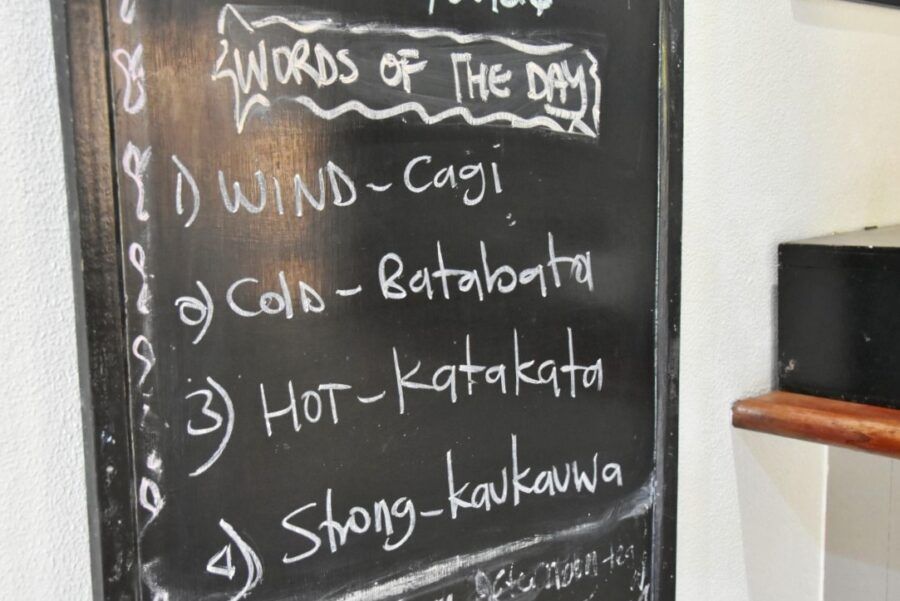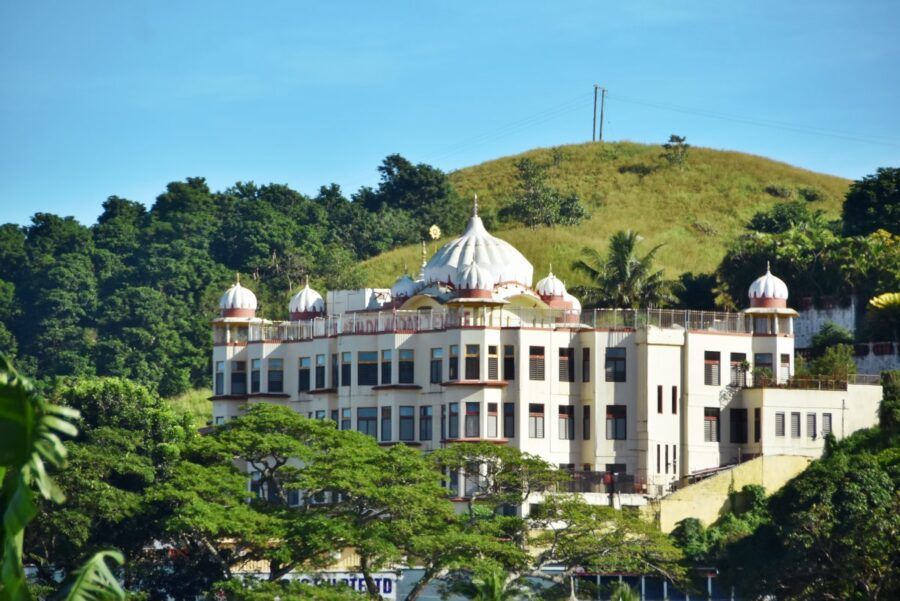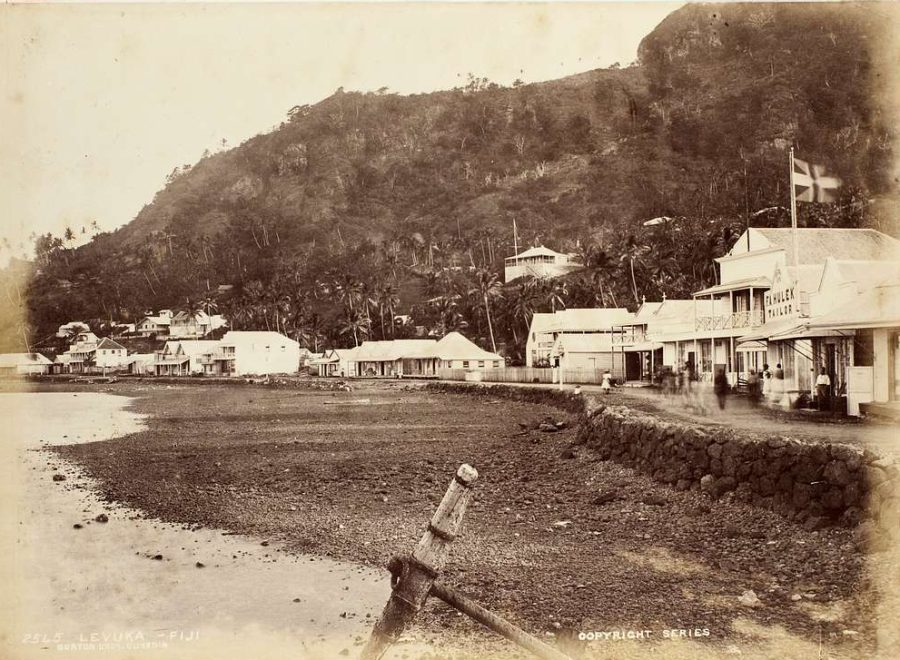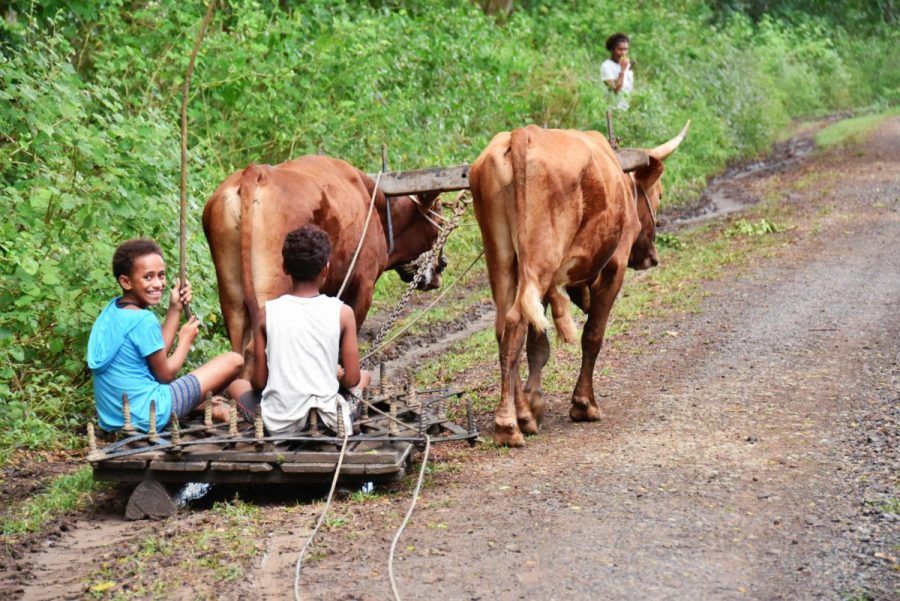The iTaukei and Indo-Fijian Culture, Traditions and Customs
What sets Fiji apart from being just another archipelago of gorgeous islands, azure waters and tropical sunshine? The culture. Fiji has two distinct cultures, Fijian (iTaukei) and Indo-Fijian. The one you’re likely to interact the most with as a traveller is the Fijian culture – from the moment you step off the plane to the song of serenaders in the airport lounge to warm smiles and friendly “Bulas!” each day at your resort. While Fijians will “put on a show” with traditional meke performances often seen at resorts, rest assured that the culture here is authentic and holds onto traditional values. Learn more about the Fijian culture in this guide to the Fiji culture for travellers.
Table of Contents
10 Ways to Experience the Fijian Culture as a Visitor
Before we get into the traditions and customs of the Fijian culture, here are some ways to experience the culture as a visitor:
- Do a village visit or a village stay
- Take part in a kava ceremony
- Check out a firewalking ceremony
- Indulge in a lovo feast
- Watch traditional meke dancing
- See historical sights like the Tomb of Udre Udre or Naihehe Caves
- Browse the handicraft or local produce markets
- Do a Fijian crafting lesson
- Do a Fijian cooking lesson
- Join a local for mud-crabbing or handline fishing.
Learn more about each experience and many more in the 20 Best Ways to Experience the Fijian Culture. You may also want to check out How to Have an Authentic Fijian Experience. In the meantime, let’s dive deeper into the Fijian culture…
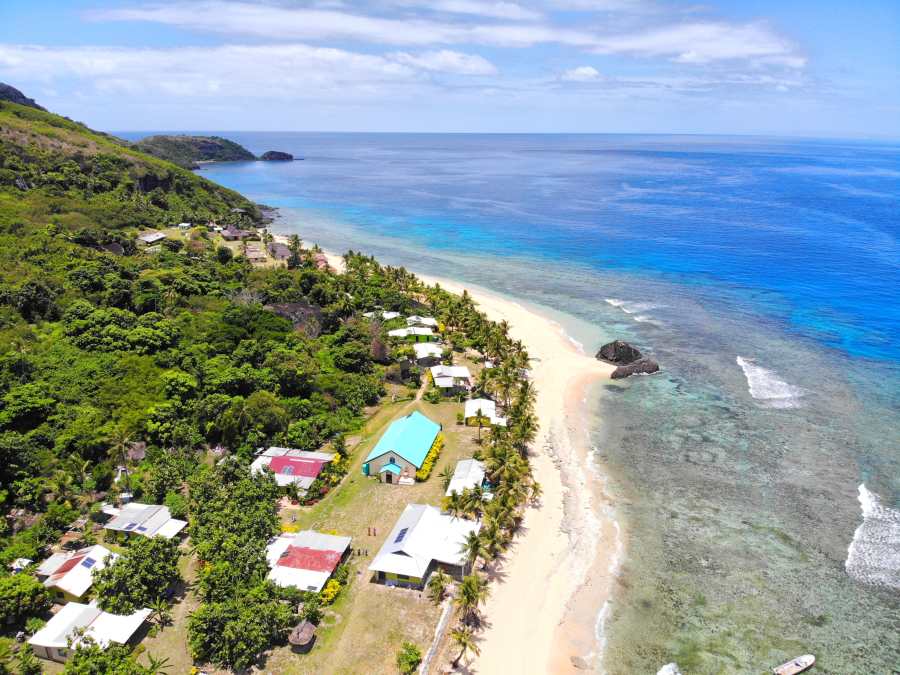 © FijiPocketGuide.com
© FijiPocketGuide.comVillage Life and Fijian (iTaukei) Societal Structure
Despite disturbances to the Fijian way of life through British colonisation for 96 years and the integration of Indo-Fijians and tourism, Fijian village life is still strong and holds traditional values. Villages are led by a chief, and family groups live together to provide communal care for all.
Fiji’s House of Chiefs
Fijian society is traditionally structured around three main confederacies, which form the backbone of the country’s political and social hierarchy. These are the Kubuna, Burebasaga, and Tovata confederacies. Each confederacy is made up of various provinces and is governed by chiefs. The Kubuna Confederacy, for instance, is historically the most prestigious, with the Vunivalu of Bau traditionally regarded as the highest chief.
Tovata Confederacy
This is one of the most influential confederacies, comprising regions such as Bua, Macuata, Cakaudrove, and Lau. It is unique in that it does not have a paramount chief but operates under the principle of veirogorogoci, meaning mutual respect and listening to each other among its chiefs.
Burebasaga Confederacy
The Burebasaga Confederacy covers much of southern and western Fiji, including Rewa, Nadroga, and Kadavu. Unlike the Kubuna Confederacy, it does not operate with a strict hierarchical system, making it more of a loose association of autonomous tribes. The Roko Tui Dreketi is considered its paramount chief.
Clan and Tribal Relationships (Tauvu)
Fijian society also has a unique system of clan or tribal relationships known as Tauvu. These relationships are often characterised by playful teasing, mutual respect, and strong ties between clans that share ancestral bonds. This system plays an essential role in strengthening social cohesion across villages and families.
What to Do if Visiting a Fijian Village
As a visitor, it’s important to bring a “sevusevu”, which is a gift to the village chief – usually yaqona. Villages are quite conservative, and everyone, including visitors, is expected to dress modestly, with their knees covered and no hats or sunglasses worn on their heads. For more about the village customs of Fiji, take a look at the Fiji Village Etiquette: What to Do When Visiting a Fijian Village.
Fijians are extremely welcoming to visitors in the village, often eager to interact and show their way of life. Villages can be experienced through guided tours or village stays – see the 10 Best Village Tours in Fiji and 15 Authentic Village Stays in Fiji.
![A Traveller's Guide to the Fiji Cultures 🌺 [2025]](https://fijipocketguide.com/wp-content/uploads/2021/12/Kunals-Wine-Dine-Restaurant-CREDIT-Fiji-Pocket-Guide--1024x684.jpg) © FijiPocketGuide.com
© FijiPocketGuide.comThe Indo-Fijian Culture
Without knowing the context of Fiji’s history, many tourists are surprised to find a significant Indian population on a South Pacific Island. Indo-Fijians are the descendants of indentured labourers brought here in the 1870s until the early 1900s to work the sugar and copra plantations.
As a result of being on the islands for generations, Indo-Fijians have their own distinct culture with their dialect, cuisine with influences from the South Pacific, music and more. That’s not to say that aspects of the traditional Indian culture are not a major part of Fiji life, with Hindu temples and mosques seen around the country, sari shops abundant in the town centres, and large celebrations for events like Diwali and the Prophet Mohammed’s Birthday. It’s an interesting aspect for visitors to experience India in the South Pacific.
It’s also important to note that the Indo-Fijian culture has become increasingly distinct from its Indian origins. For instance, many cultural practices have been adapted to the Fijian context, such as the dismantling of the caste system and the adoption of kava consumption. In addition, there’s a strong connection to Fiji as a homeland, with many Indo-Fijians having limited ties to India.
Learn more about the story of the Indo-Fijians in A Brief History of Fiji.
![A Traveller's Guide to the Fiji Cultures 🌺 [2025]](https://fijipocketguide.com/wp-content/uploads/2021/12/Cute-Church-CREDIT-Fiji-Pocket-Guide--683x1024.jpg) © FijiPocketGuide.com
© FijiPocketGuide.comReligion in Fiji
Religion plays a large part in the Fijian lifestyle. Almost the entire population of iTaukei people are part of a Christian denomination, mostly of the Wesleyan persuasion. The rest of the religious majority are Hindu or Muslim, with small numbers identifying with Sikhism, Buddhism, Confucianism and the Baha’i Faith.
Fijian Churches
Church in Fiji is the centre of village life, where iTaukei locals go at least every Sunday for mass. Visitors are welcome to join for Sunday worship, where they will be treated to powerful harmonious singing by the locals. Just be sure to dress appropriately with your knees and shoulders covered.
Temples and Mosques
Hindu temples and Muslim mosques are equally as important to much of the Indo-Fijian population, with these places of worship mainly located in the main towns of each region. Hindu temples, particularly in Nadi, are open to visitors and offer cultural experiences. When visiting religious sites, visitors should dress modestly and respectfully.
Learn more about Fiji’s diverse religions in the Guide to the Religions in Fiji.
![A Traveller's Guide to the Fiji Cultures 🌺 [2025]](https://fijipocketguide.com/wp-content/uploads/2021/12/Weaving-Village-Crafts-Local-CREDIT-Fiji-Pocket-Guide--683x1024.jpg) © FijiPocketGuide.com
© FijiPocketGuide.comFijian (iTaukei) Arts, Crafts and Dance
One of the most engaging ways that visitors get to experience the Fijian culture in Fiji is through their arts and crafts, including dance performances.
Fijian Meke
“Meke” is Fiji’s style of dancing and singing. It combines dance and telling Fijian myths and legends through song. The Fijian meke is performed by a group of men and women.
There are various types of meke, including sitting dances (meke wesi), fan dances (meke thali), and standing dances performed by women (seasea). Performers often wear traditional attire such as masi cloth and grass skirts during the performance. The singing may be accompanied by the beating of the lali drum, hand clapping or some other percussion instruments.
Traditionally, meke are performed for special occasions and tells stories of history, culture and mythology. Today, Fijian meke is often performed at least once a week in selected resorts around Fiji, many of which we list in the 20 Best Cultural Activities in Fiji.
Fijian Crafts
Crafts are an integral part of Fijian life, especially since crafting has many uses in the Fijian lifestyle. Weaving (talitali) is an important skill passed down through generations in Fiji, mainly between women. Plant fibres, especially from coconuts and pandanus, are plaited to create useful items such as mats (ibe or yoni), baskets (kato), fans (iri), and other objects. These items are not only practical but often display decorative patterns and are used during ceremonies. Some resorts and village stays around Fiji offer weaving lessons to tourists.
Masi is a traditional bark cloth made from the inner bark of the paper mulberry tree. It is stripped, beaten, and often decorated with intricate designs, primarily created by women. The cloth is a significant cultural artefact used in ceremonies, as gifts, and for traditional attire.
Pottery is also a popular craft in Fiji, with each region having its own unique pottery style. Pottery making in Fiji dates back approximately 3,000 years, introduced by the Lapita people who first settled the islands. In some regions, a girl’s first pot marked her transition to womanhood and readiness for her societal role. Clay pots (kuro ni viti) traditionally served both practical and ceremonial purposes in Fijian society. While pottery making declined after World War 2, efforts to revive the tradition continue in some villages and pottery demonstrations and sales have become part of cultural tourism experiences in Fiji.
![A Traveller's Guide to the Fiji Cultures 🌺 [2025]](https://fijipocketguide.com/wp-content/uploads/2021/12/Nama-Seagrapes-Traditional-Food-Nawi-Island-Restaurant-3-CREDIT-Fiji-Pocket-Guide--1024x684.jpg) © FijiPocketGuide.com
© FijiPocketGuide.comFijian Food and Drink
Like most cultures, food plays an important role in the Fijian lifestyle. For your complete bible to all things “food”, check out The Food Guide to Fiji: Places to Eat & Food Tours.
Fijian Food
Traditional ingredients used in Fijian cooking include cassava, fish, coconut, sweet potato, breadfruit, taro and rice. With that, there are a number of Fijian dishes that are a national speciality; the most abundant that visitors will see on menus is kokoda. Kokoda is raw fish in coconut cream with lemon or lime juice.
Another iconic meal is the lovo, a traditional Fijian cooking method where food is slow-cooked in an underground oven. Ingredients like meat, fish, or vegetables are wrapped in banana leaves and cooked with hot stones, giving the food a smoky flavour and tender texture. Typical lovo dishes include Lovo Chicken, Lovo Lamb, and Lovo Pork, served with sides like dalo (taro root) and cassava.
See more local specialities in the 20 Unique Foods in Fiji You Have to Try.
Fijian Drink
Fiji’s national drink is yaqona, otherwise known as kava. The drink is prepared from the root of a pepper plant mixed with water. Yaqona is a fundamental part of a welcoming ceremony when new visitors arrive at a village, where visitors are expected to provide the yaqona root. See Fiji Village Etiquette: What to Do When Visiting a Fijian Village for more details on what to do if you are visiting or staying at a Fijian village.
Two locally cherished teas among Fijians are lemon leaf tea, known as drau ni moli, which offers a delightful fragrance and subtle citrus notes from lemon tree leaves. For a different twist, try lemongrass tea, called co boi in Fijian, made from aromatic lemongrass stalks.
See more local drinks you can try in the 10 Drinks in Fiji You Have to Try.
Indo-Fijian Food
Indo-Fijian cuisine is a mouthwatering blend of Indian traditions and Pacific influences. Food preparation from the subcontinent has been adapted to incorporate local Fijian ingredients, creating a unique culinary experience. Seafood takes centre stage in many dishes, thanks to Fiji’s island geography. But don’t worry, you’ll still find the holy trinity of Indian cuisine: rice, dhal (lentils), and curry at the heart of most meals. Roti, a flatbread, is another staple – perfect for scooping up curries or as a wrap for tasty fillings.
For a true taste of Indo-Fijian culture, don’t miss out on masala tea, a fragrant brew enjoyed in many households. And if you have a sweet tooth, you’re in for a treat! Indo-Fijian sweets offer a delightful mix of traditional Indian flavours and local twists. Keep an eye out for mithai like gulab jamun, barfi, and ladoo at local markets – your taste buds will thank you!
![A Traveller's Guide to the Fiji Cultures 🌺 [2025]](https://fijipocketguide.com/wp-content/uploads/2021/12/Cicia-Village-Visit-Meke-7-CREDIT-Fiji-Pocket-Guide--1024x684.jpg) © FijiPocketGuide.com
© FijiPocketGuide.comThe Fijian Language
The official languages of Fiji are: English, Bauan Fijian and Hindustani. However, English is the most widely spoken.
Fijian (Vosa Vakaviti)
While there are many Fijian dialects throughout the islands, Bau Fijian is the most recognised.
When saying Fijian words, note that there are some letter pronunciations that are different from the English language. For instance, the letter “c” is pronounced “th”, the letter “d” is pronounced with an “n” before it, the letter “b” is sometimes pronounced with an “m” before it, and more like that follows.
Fiji-Hindi
Fiji-Hindi is an official language in Fiji. Although the language is called “Hindi” locally, outsiders refer to the language as Fijian Hindi or Fiji-Hindi due to the variations of the language compared to the Hindi spoken in the Indian subcontinent. The language has combined elements of the Hindi dialects from Awadhi and Bhojpuri variations of the language, mixed with Fijian, Arabic and English words.
Learn more about the Fijian language in the Guide to the Fijian Language.
![A Traveller's Guide to the Fiji Cultures 🌺 [2025]](https://fijipocketguide.com/wp-content/uploads/2021/12/Mums-Kitchen-Staff-Locals-CREDIT-Fiji-Pocket-Guide--1024x684.jpg) © FijiPocketGuide.com
© FijiPocketGuide.comPeople and the Population of Fiji
The population of Fiji is approximately 884,887, and the ethnic makeup is around 55% Fijian (iTaukei) and 40% Indo-Fijian.
The majority of those living in Fiji live on the islands of Viti Levu and Vanua Levu, with around 56% living in urban areas and 44% living rurally.
Learn more about the Fijian population, ethnicity and where Fijians live in our complete guide, Who are the People of Fiji?
![A Traveller's Guide to the Fiji Cultures 🌺 [2025]](https://fijipocketguide.com/wp-content/uploads/2021/12/Village-Kava-Ceremony-5-CREDIT-Fiji-Pocket-Guide--1024x684.jpg) © FijiPocketGuide.com
© FijiPocketGuide.comFijian Customs
As discussed throughout this guide to the Fijian culture for travellers, Fijian is a rich culture that, in turn, comes with a few cultural customs that should be kept in mind when visiting.
Clothing Etiquette in Fiji
It is Ok to wear revealing attire at your resort (as long as it is not literally “nothing”). When it comes to clothing in Fiji’s towns and villages, however, as both of Fiji’s predominant cultures are religious, it is more respectful to wear more modest attire. This is taken particularly strictly in Fijian villages, where both men and women are expected to wear clothing that covers the knees and shoulders. The most accepted form of this is wearing a sulu (sarong). It is also important to not wear anything on your head in a Fijian village, such as a hat or sunglasses.
Presenting a Sevusevu
A long-standing tradition that is still important to partake in, even for international visitors, is presenting a sevusevu to the village chief when visiting a Fijian village. This is usually arranged by tour guides if you’re on a guided experience. If you are doing a village homestay or visiting to see a natural attraction, etc., you are expected to present a sevusevu yourself. Learn more about this cultural etiquette in Fijian & Indo-Fijian Etiquette: Fiji Village Customs & Traditions.
Other Fijian Customs and Etiquette
Unless you’re visiting a traditional Fijian or Indo-Fijian home, there’s not much more to add to the list of rules and etiquette for Fiji other than that tipping is not expected but welcomed, remove shoes before entering homes, schools or bures, and to avoid touching people’s heads. Go into all of the details of these customs in Fijian & Indo-Fijian Etiquette: Fiji Customs & Traditions.
More About the Fijian Culture
That’s it for our complete guide to the Fiji culture and Indo-Fijian culture. For more cultural tips, take a look at the following articles:
- 15 Fijian Words You Need to Know When Visiting Fiji
- Who are the People of Fiji?
- Fiji Luxury Itinerary: 7 Days / One Week (Culture & Nature)
- Fiji Food Itinerary: 7 Days / One Week (Islands & Culture)
- How to Have a Real Fiji Cultural Experience
Finally, see what popular cultural events are happening in our Travelling Fiji: Month-by-Month Guide and the 10 Best Festivals in Fiji.
Sources:
The information in this guide has been compiled from our extensive research, travel and experiences across Fiji and the South Pacific, accumulated over more than a decade of numerous visits to each destination. Additional sources for this guide include the following:
- Tourism Fiji (General travel advice - Updated [2025])
- Fiji Immigration (Visa and immigration advice - Updated [2025])
- Fiji Revenue & Customs Service (Customs and visitor taxes - Updated [2025])
- Biosecurity Authority of Fiji (Biosecurity advice - Updated [2025])
- Fiji Meteorological Service (Weather forecast and warnings - Updated [2025])
- Fiji Bureau of Statistics (Statistics and travel data - Updated [2025])
- Ministry of Tourism and Civil Aviation (Tourism statistics - Updated [2025])
- Land Transport Authority (Road safety advice - Updated [2025])
- Safe Travel (New Zealand travel advisory for Fiji - Updated [2025])
- Smart Traveller (Australia travel advisory for Fiji - Updated [2025])
- Travel.State.Gov (U.S. travel advisory for Fiji - Updated [2025])
- SPTO (Pacific tourism advice - Updated [2025])
- Fiji Hotel and Tourism Association (Tourism trade association - Updated [2025])
Our editorial standards: At Fiji Pocket Guide, we uphold strict editorial standards to ensure accurate and quality content.

About The Author
Laura (Lora) S.
This article was reviewed and published by Laura, editor in chief and co-founder of Fiji Pocket Guide. Since arriving solo in the South Pacific over 10 years ago with nothing but a backpack and a background in journalism, her mission has been to show the world how easy (and awesome) it is to explore a paradise such as Fiji. She knows the islands inside-out and loves sharing tips on how best to experience Fiji’s must-dos and hidden gems. Laura is also editor of several other South Pacific travel guides.
![A Traveller's Guide to the Fiji Cultures 🌺 [2025]](https://fijipocketguide.com/wp-content/uploads/2021/12/Cicia-Lau-Village-School-Children-Meke-CREDIT-Fiji-Pocket-Guide--e1729536240232-1194x650.jpg)
![A Traveller’s Guide to the Fiji Cultures 🌺 [2025] A Traveller's Guide to the Fiji Cultures 🌺 [2025]](https://fijipocketguide.com/wp-content/uploads/2021/12/Cicia-Lau-Village-School-Children-Meke-CREDIT-Fiji-Pocket-Guide--e1729536240232.jpg)


